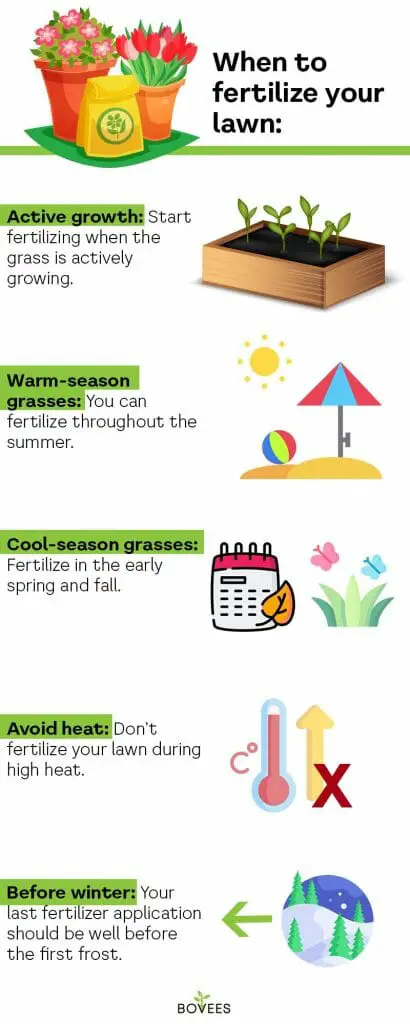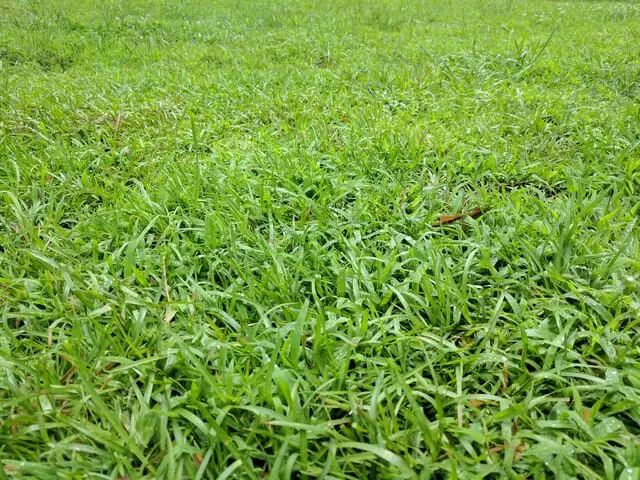Last Updated on May 17, 2022 by Grow with Bovees

When winter is ending and spring is around the corner, the growing season starts and it’s time to start planning your fertilizing and lawn care schedule for optimal grass growth in your yard.
It is easy to make mistakes, like applying the wrong amount of nutrients or at the wrong time, but when you fertilize your lawn correctly, you’ll keep it dark green and growing all through the warm season.
But when do you start to fertilize your lawn, and how often do you do it?
We set up this lawn care guide, so you’ll know exactly how often to fertilize your lawn and how to make it happen.
Here are some of the things we’re going to go through in this article.
- How do I know how often to feed lawns?
- When you need to apply fertilizer.
- What to do after your first use of lawn fertilizer.
- What brand of fertilizer to use on your lawn
- What’s in your lawn fertilizer?

How Do I Know How Often To Fertilize Lawns?
If you feed too little you won’t feed your lawn with the nutrients it needs, and it may turn brittle and yellow. Apply too much fertilizer, or over fertilize, too early or late, and you can burn the blades or cause excessive grass growth.
Most lawns will do fine with fertilizing one or two times a year, in the early spring and the fall during the growing season, but this depends on the type of lawn you have.
Some people do it four times per year. In this case, we recommend keeping in mind the big holidays to do it: around Easter, Memorial Day, Labor Day, and Halloween.
Depending on your lawn, you can feed up to once every four or five weeks if using synthetic fertilizers. If you have a slow-release fertilizer that is plant based or organic, you can space out the applications for eight to 10 weeks. Never feed in intervals of two weeks, you will damage your grass.
Avoid lawn fertilizing in the peak temperatures of the summer. The heat and blazing sun together with the fertilizers can damage your grass by causing lawn burn.
When To Apply Fertilizer
These are the common types of grass and the ideal time to fertilize them.
Warm-Season Grasses
Warm-season grasses, which are common in the southern states, start to actively grow in the summer. This type of grass includes carpetgrass, zoysiagrass, St. Augustine grass, and Bermudagrass.
The right moment to provide them with some lawn food is starting in late spring when the grass is green and in full growth. You can fertilize your green lawn throughout the summer, but avoid fertilizing when you’re getting closer to the fall.
If you fertilize zoysia grass and other warm-season grass, too late in the year will weaken the healthy lawn in the winter when it’s dormant.
Cool-Season Grasses
Cool-season grasses, like Kentucky bluegrass, ryegrass, bentgrass, and fescue grass, grow most in the early spring or fall. In the spring, fertilize when the grass is actively growing, around the same time you start to mow it.
In the fall, fertilize your lawn when temperatures drop. It’s usually best to wait at least until Labor Day to fertilize cool-season grasses, so you won’t put stress on the grass or chemically burn it.
However, make sure to fertilize no later than about six weeks before the first anticipated frost date. If you do it too late in the fall, it might weaken your lawn. A well looked after lawn usually does not need a second round of fertilizer.
What To Do After Your First Use of Lawn Fertilizer
After you apply slow release fertilizers, keep these tips in mind.
- Don’t use the lawn for at least 24 hours. Keep pets and children away from the grass until it’s completely dry and the soil has absorbed the fertilizers.
- Don’t mow for 48 hours. Avoid mowing the lawn for the first couple of days after you apply fertilizers, because it can move the fertilizer on the lawn surface around before it’s set.
Applying Fertilizer When Grass Is Growing
The best moment for fertilizing your lawn is when your turf is in an active growing phase. This is why it’s key to identify what type of grass you have.
Fertilizing your lawn when it’s growing will make the most out of the growth and supply nutrients to ensure strong roots and to keep your lawn healthy and the grass green.

What Type of Fertilizer To Use on Your Lawn
When picking fertilizers for your lawn, you have the option of liquid or granular, and synthetic or organic.
- Liquid: Fast and effective, but tough to spread and used mostly by professionals, may require the use of a backpack sprayer for large areas.
- Granular: Easiest to spread, the best option for the average homeowner.
- Synthetic Fertilizers: Made out of synthetic components, release their nutrition fast.
- Organic: Organic fertilizers for lawns are made from plants and animals, and are usually of the slow-release type. This is a longer lasting fertilizer and fewer applications are necessary.
- Starter fertilizer: Quick release product used when starting new lawns.
Grass Clippings
When mowing your lawn, it can be beneficial to leave the remaining grass blade clippings on the lawn. These clippings serve as a natural fertilizer and can provide your soil with essential nitrogen, stimulating its biological activity.
It is, however, important to remember that the clippings are not too long and that the layer that remains is not too thick. A too thick layer can end up suffocating your healthy grass.
What’s in Your Lawn Fertilizer?
Fertilizer for lawns has three key macronutrients to feed your lawn: nitrogen, phosphorus, and potassium, or NPK. The proportion of each nutrient is usually marked on the bag with these letters.
Nitrogen is the component that makes your lawn grow, while phosphorus and potassium help develop strong roots and cell walls of the grass.
The amount of nitrogen you need depends on your soil and grass type. Apply the right amount and you’ll get healthy green grass. Too heavy on the nitrogen and you’ll need to mow all the time, and the grass may not be strong or green.
You can also find fertilizers that contain a weed preventer. This is great to use at the start of summer ensuring a typically healthier lawn.
How To Apply Lawn Fertilizer To Your Lawn
Here’s how to go about fertilizing your lawn.
1. Two Days Before
About 48 hours before you’re planning to fertilize, give your lawn a thorough watering and let dry. Don’t fertilize over wet grass, and don’t do it if you’re expecting heavy rain in the next two days.
2. Pick Your Spreader
These are the most common types of spreaders for granular fertilizers.
- Rotary: Works best when you have a big area to fertilize.
- Drop: Great for controlled fertilizer application.
- Handheld: These small spreaders are ideal for a tiny backyard, or if you have areas that require a different fertilizer.
3. Fill the Spreader
Fill the spreader from the bag up until a point where you still feel comfortable moving it around. You can lay a tarp on the ground to recover any spilled fertilizer.
4. Start Going Over the Lawn
Go over the perimeters of your turf to cover everything. Then, move the spreader along in orderly rows across the turf. The rows can overlap slightly to make sure everything gets covered.
If you use a drop spreader, close the hopper at the end of each pass so you don’t dump fertilizer at the edges of your lawn.
5. Covering Accidents
If you do end up dumping too much fertilizer onto your lawn, pick up a broom to spread it out over a bigger area.
You can also apply more water to this spot to make sure all the fertilizer gets into the ground and doesn’t burn the blades, which in turn may cause yellow patches.
Watering Grass After Fertilizer Application
You should always give your lawn a watering after fertilizer. This washes the nutrients off the blades and into the ground, where they feed the roots.
Just don’t water too heavily, or the fertilizer can travel too deep into the soil, or even off your lawn if it slopes.
Maintenance of Your Lawn After Fertilization
To fertilize a little less, leave the grass clippings on the turf after mowing. This is a natural way of putting nitrogen back into your soil and the roots.
If you are wondering whether and when to fertilize new grass, you can find out here.
To make this technique even more effective, try a mulching blade on your lawnmower. This cuts the grass into smaller pieces that will more readily start the decomposition process in your compost pile.
If your soil is of a heavy-clay nature, or you have a lot of traffic on the grass, then it may be useful for you to consider some type of manual lawn aeration from time to time. If you have a large lawn area to aerate, then you may need to use a tow behind aerator that can be pulled with your garden tractor.
The Takeaway
Got it? Let’s go through everything once more so you can start with your lawn care and applying fertilizer.
How often to fertilize my lawn and the moment to start fertilizing depends on where you live and what type of lawn you have.
A good rule of thumb is to fertilize early in the year when your lawn is in its best growing season and starts looking green.
With warm-season grasses, you can fertilize several times from early summer to late summer, up to every four to five weeks. With cool-season grasses, two times a year, once in the early spring and another in the fall, is usually enough.

